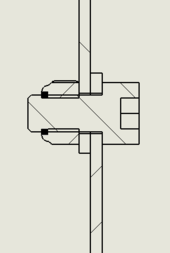- Nyloc nut
-
A nyloc nut, also known nylon insert lock nut, polymer insert lock nut or elastic stop nut (although incorrectly, as an elastic stop nut is broad class of locking nuts), is a kind of nut that includes a nylon collar insert. The insert is placed at the end of the nut and its inner diameter (ID) is slightly smaller than the major diameter of the screw. The insert deforms elastically over the threads of the screw, but threads are not cut into the nylon. The nylon insert locks the nut in two ways. First, it forces the bottom face of the screw threads against the top face of the nut threads, increasing the friction between the two. Second, the nylon applies a compressive force against the screw itself. Nyloc nuts retain their locking ability up to 250 °F (121 °C).[1]
Nyloc is a registered trade name of Forest Fasteners.[2] In Australia "Nyloc" is a registered trade mark of Exafast Pty Ltd.
Nylon pellet nut
A nylon pellet nut is very similar to a nyloc nut except that it uses one or more smaller nylon inserts instead of a ring of nylon. They do not lock as strongly as nyloc nuts.[1]
Reuse
Authorities disagree on whether nyloc nuts should be reused. For example, Smith notes that the nylon insert is not damaged by installation and therefore they can be reused many times,[1] and a Federal Aviation Administration Advisory Circular allows nuts to be reused if the prevailing torque is within specification.[3] However, an Air Force Technical Order requires replacement of self-locking nuts in critical areas.[4] Various specifications for aerospace-grade self-locking nuts require that the running torque be maintained after a number of cycles of assembly, but without preloading the fastener.[5]
References
- ^ a b c Smith, Carroll (1990), Carroll Smith's Nuts, Bolts, Fasteners, and Plumbing Handbook, MotorBooks/MBI Publishing Company, p. 104, ISBN 0879384069, http://books.google.com/?id=A81HmmRCN7YC.
- ^ Glossary of Terminology Related to Nuts and Bolts, http://www.boltscience.com/pages/glossary.htm, retrieved 2008-11-25.
- ^ FAA AC43.13-1B
- ^ Air Force T.O. 1-1A-8
- ^ NASM 25027, SPECIFICATION, NUT, SELF-LOCKING, 250°F, 450°F, AND 800°F
Categories:- Fasteners
Wikimedia Foundation. 2010.


